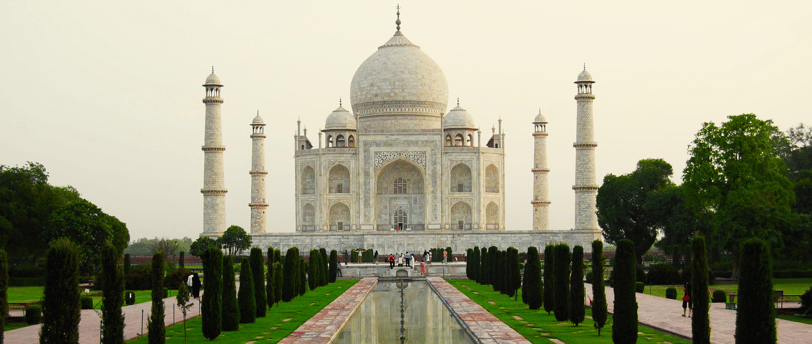The Eternal Embrace: Exploring the Emotional Majesty of the Taj Mahal
Some places you visit with your eyes. The Taj Mahal? You feel it with your soul.
4/18/20253 min read


A Monument to Love That Transcends Time
Nestled on the banks of the Yamuna River in Agra, India, the Taj Mahal is far more than a stunning architectural wonder — it is a living, breathing poem carved in marble. Built in the 17th century by the Mughal Emperor Shah Jahan as a mausoleum for his beloved wife Mumtaz Mahal, this UNESCO World Heritage site continues to stir hearts centuries later.
Every year, millions of visitors stand in awe before its ivory-white domes. But beyond its beauty, the Taj Mahal is a place of reflection, remembrance, and emotional healing. It's where history whispers through the arches, and where love, even in loss, still echoes in stone.
The Story Behind the Stone
The Taj Mahal is not just a monument — it is a love letter.
When Mumtaz Mahal died giving birth to their 14th child, Shah Jahan was devastated. In his grief, he commissioned an unparalleled tribute to their love. It took over 20,000 artisans and 22 years to complete. Every curve, every inlay, every glimmer of semi-precious stones speaks of devotion that refused to fade.
This story, etched in every marble petal of the Taj, is what continues to make it one of the most emotionally moving places on Earth.
Why the Taj Mahal Moves Us
1. Architecture That Breathes Emotion
From its perfectly symmetrical gardens to the way the light dances on its surface at sunrise and sunset, the Taj Mahal evokes serenity, balance, and longing.
2. The Power of Stillness
Standing in front of the main mausoleum, there's a hush that falls over even the most crowded day. Visitors speak in whispers, overcome by an inexplicable sense of reverence. It’s as though the building itself invites you to slow down, breathe, and remember what matters.
3. Beauty That Mirrors Grief and Hope
The Taj doesn’t just celebrate love — it honors loss. It reflects the quiet ache of longing and the resilience of memory. It’s a reminder that even in death, love can create something eternal.
What to See and Feel at the Taj Mahal
The Main Mausoleum
Experience: Awe. Stillness. The weight of legacy.
Details: Octagonal structure, Persian calligraphy, inlaid jasper and jade.
The Reflecting Pool and Charbagh Gardens
Experience: Peace. Tranquility. Emotional grounding.
Details: Islamic-inspired symmetry, lotus fountains, lush greenery.
The Mosque and Jawab
Experience: Sacred quiet. Spiritual connection.
Details: Red sandstone structures flanking the main building.
The View from Mehtab Bagh
Experience: Reflection. Distance. Perspective.
Details: Located across the Yamuna River, this is the perfect place to witness the Taj Mahal during sunset in near solitude.
How to Visit the Taj Mahal Mindfully
1. Go Early or Stay Late
Sunrise and sunset offer the most magical light — and the quietest atmosphere.
2. Take Your Time
Don’t rush. Sit in the gardens. Watch the shadows change. Let yourself feel.
3. Journal or Meditate
Capture your emotions as they arise. The Taj Mahal is a place that speaks to the soul.
4. Learn Before You Arrive
Understanding the story behind the monument deepens its emotional impact.
5. Consider a Guided Tour
Local guides can share hidden stories and cultural nuances that transform your visit into something unforgettable.
Getting There
Closest Major City: Delhi, India
How to Get There: Train (2–3 hours), car (4–5 hours), or domestic flight to Agra’s small airport
Entry Tips: Foreign visitors need to purchase tickets in advance. Closed on Fridays.
Best Time to Visit: October to March for cooler weather and clearer skies
Real Reflections from Travelers
"I thought I was coming to see a building. Instead, I found myself crying under a tree in the garden, thinking of my late grandmother. I didn’t know I needed to grieve — the Taj gave me that space." — Alison, 34
"There’s something sacred about it. Not just religious — emotional. It’s where you can feel history’s heartbeat." — Rahul, 28
More Than a Destination
The Taj Mahal is not a checklist monument. It’s not something to simply photograph and move on from. It is a place to feel — deeply, honestly, and without hurry.
Whether you’re mourning someone, remembering a past love, or just needing to be reminded that beauty still exists in the world, the Taj Mahal opens its marble arms to you.
Let Your Heart Lead the Way
Ready to stand where love has stood for centuries? Start planning your mindful journey to the Taj Mahal today.